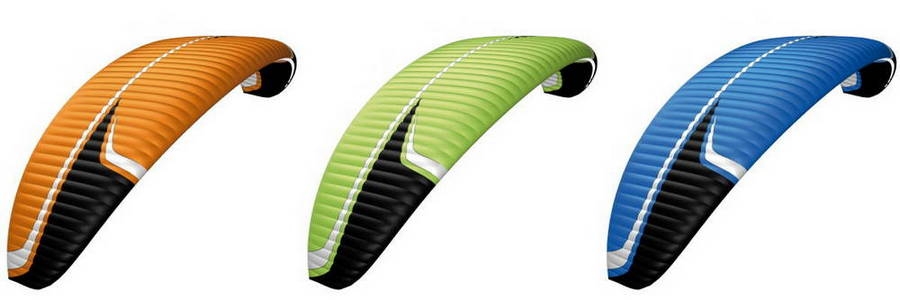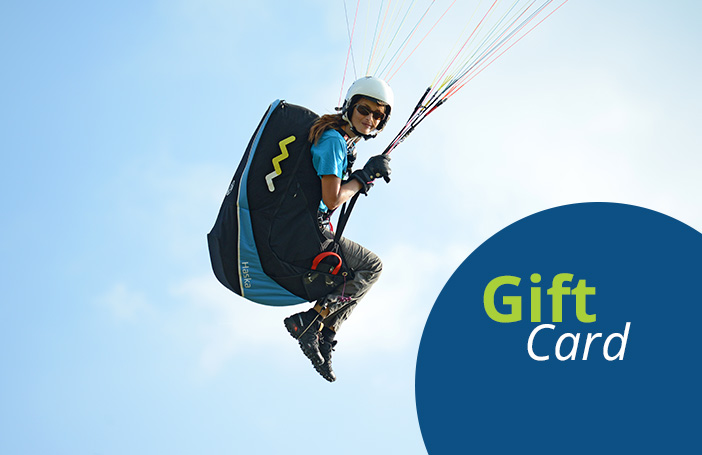
Niviuk Link 2
Select all options to view stock availability

When in stock, UK approx 2-5 workdays, other countries see shipping page
Specifications
Size |
21 |
23 |
25 |
27 |
| Cells # | 55 | 55 | 55 | 55 |
| Aspect ratio Flat | 5.1 | 5.1 | 5.1 | 5.1 |
| Aspect ratio Projected | 3.91 | 3.91 | 3.91 | 3.91 |
| Area Flat m2 | 21 | 23 | 25.5 | 27.5 |
| Area Projected m2 | 18.27 | 20.01 | 22.19 | 23.93 |
| Chord Max m | 2.51 | 2.63 | 2.77 | 2.88 |
| Lines Total m | 254 | 267 | 282 | 294 |
| Main lines | 2+1/4/3/2 | 2+1/4/3/2 | 2+1/4/3/2 | 2+1/4/3/2 |
| Risers (4) | A+A'/B/C/D | A+A'/B/C/D | A+A'/B/C/D | A+A'/B/C/D |
| - Trimmers mm | 170 | 170 | 170 | 170 |
| - Acc mm | 85 | 85 | 85 | 85 |
| Speeds km/h trim | 40 | |||
| - open trimmers | 51 | |||
| - max | 56 | |||
| TOW* min-max kg | 55-100 | 70-120 | 90-145 | 105-170 |
| Glider weight kg | 4.8 | 5.1 | 5.5 | 6.0 |
| Certification | DGAC / EN-962-1 | DGAC / EN-962-1 | DGAC / EN-962-1 | DGAC / EN-962-1 |
*TOW (take off weight)
Colours
Standard colours: Hardos (orange), Cherimoya (green), Jazz (blue)

Package
- Wing
- Inner bag
- Compression strap
- Riser bag
- Repair kit (patches)
Note: Backpack not included
Optional extras
Link 2 - Reach new horizons
PPG Progression | DGAC
The freedom to have everything under control
The first steps are not necessarily the most complicated. Enjoy your paramotor flights with an Easy Handling wing, which is simple at take off and landing, with comfortable and precise handling throughout the flight. A glider for progression and enjoyment.
Safety on all your journeys
The Link 2 has an optimised internal architecture that is constructed using new materials and technologies to ensure maximum safety. From the moment of take off until landing, the Link 2's feedback will turn flights into safe experiences for the pilot.
The comfort of great performance
Its internal structure has been redesigned and optimised to achieve greater comfort during each phase of the flight. In addition, the Reflex System Profile system provides the wing with greater stability and more efficiency.
All about Link 2
Enter a new and wonderful world of adventures. With the Link 2 you will discover a wing with all the necessary features to make your first paramotor flights. Its simple and intuitive handling is combined with maximum safety to provide you with the best flight experience and allow you to expand your horizons through paramotoring.
From the moment of take off you will experience a wing ready to make things simpler for you. Thanks to an optimisation of the cell openings and attachment points, the inflation phase has become more progressive and easy to control. Once in the air, let yourself be carried by a wing that adapts to all your needs. Because of the use of our RAM Air Intake technology, which ensures optimal maintenance of internal wing pressure, a more consistent profile is achieved, allowing more control and stability in the roll and pitch.
In flight, the wing's performance stands out thanks to the implementation of RSP (Reflex System Profile) technology. With this technology we manage to provide the wing profile with its own intelligence and efficiency. In this way, the wing utilises the favourable inertia with minimum input from the pilot. With the Reflex System Profile, the engine does not need much power to achieve greater thrust, resulting in less consumption, more autonomy, less need for power, better durability, mechanical efficiency and increased performance.
The Link 2 will also surprise you with its versatility and its different speed ranges. Thanks to a greater rigidity in the front of the wing it is possible to reach and maintain a high speed (max. 55 km/h), without deformations in the leading edge, while allowing the profile to maintain the mobility necessary to absorb turbulence in rough air. The trimmer system is extremely effective and easy to use. It increases the speed by 20%, in comparison with the previous model. In addition, the wing has an excellent ability to turn, it is precise and solid, ideal for its category.
In comparison to its predecessor, the design has evolved not only in performance, but also in durability. New technologies were used during the manufacture, for example, a new pattern and cutting system for the fabric panels and a reinforced seam at the leading edge. In this way, the fabric is tauter, without creases and ensuring a cleaner profile. At the same time, the structure of the wing is reinforced with Nitinol, making it lighter and giving it more flexibility.
In conclusion, Link 2 is your best gateway to the world of paramotoring. A solid wing with simple take off and landing characteristics, very accessible handling and a stable and safe flight behaviour. A glider to assist you to learn and progress while you enjoy the paramotor world to the fullest.
Download Niviuk Link 2 product presentation (PDF)
Technologies

3DL: 3D Leading Edge
Adding an extra seam to the leading edge on the span axis of the glider helps to shape a compact 3D profile and have better connections to the new 3DP front panel's layout.
3DP: 3D Pattern Cut Optimization
The latest glider generation requires a new pattern design and an optimized fabric cutting process based on a 3D technology.
RAM: RAM Air Intake
Evolution and constant improving in all our products is the essence of the DNA of Niviuk's R&D team. Thanks to the new technologies created over recent years, we have conceived new and more evolved and higher performing gliders. In this context the RAM Air Intake technology should be pointed out.
RSP: Reflex System Profile
The highly efficient Reflex System Profile (RSP) unlike conventional reflex designs requires less engine power to achieve greater thrust, thus resulting in lower fuel consumption, more autonomy and higher overall motor efficiency.
SLE: Structured Leading Edge
The SLE provides more rigidity and stability along the span of leading edge but also allows full flexibility along the both the vertical and horizontal axis of each open cell. The SLE ensures ease of movement on the ground and high security in the air during turbulence and whilst flying at speed.
TNT: Titanium Technology
Constantly innovating, we always are on the hunt, looking for the latest and best materials to helps us design optimal products. For this reason, and after an extensive evaluation of its benefits and qualities, we decided to be the firsts manufacturer to use Nitinol in our glider line.
Learn more about Niviuk Paraglider Technologies
FAQs
Why is this wing certified through the DGAC instead of the EN standard?
Currently the EN standard is used to certify free-flying wings. This means that manufacturers have to submit their gliders for the certification tests WITHOUT the engine and therefore the results are not based on the weight or load that the wing will be subjected to in real flight.
For this reason, paramotor wings certified in accordance with the EN standard are ONLY tested within a certain weight-range and in the vast majority of cases this certified load is lower than the most common loads in actual flight.
For example, a paramotor wing (size 24) can bear a load up to 120 kg (tested for a load up to 5.25 G under the DGAC standard). Under the EN standard, this would be certified for a weight-range of 65 - 85 kg (tested for a load up to 8 G). Any pilot flying this wing with a higher wing loading, for example 105 kg, would not be complying with the EN certification.
In conclusion, if the paramotor wing is flown outside the EN certified weight-range, it is equal to flying it WITHOUT certification and therefore neither the flight test nor structural test can be seen as valid. After an in-depth analysis of this issue we have concluded that the EN certified weight-ranges are not representative of paramotor wings because they can create confusion and misinformation. Therefore, we have decided to use the DGAC certification as our main reference.
What about offering EN as well as DGAC certification?
We could also undergo the EN certification process, but designing a paramotor wing solely to obtain the certification within a certain weight-range would prevent us from optimising the type, capabilities and performance of the wing.
Our objective is to design our wings to offer maximum safety in every aspect of flight and to guarantee this for all our gliders and products on the market.
What exactly is DGAC?
DGAC is a legal document that guarantees that the brand will meet all the requirements for a particular wing to function correctly and grant maximum safety to the pilot.
In this way, we demonstrate that from the outset our wing was designed and developed with the sole objective of being flown with a paramotor, complying with the performance and safety requirements across all weight-ranges.
Niviuk Link 2 paramotor wing reviews
"When I fly the Link 2, I appreciate the ease and safety it offers, without losing any of the enjoyment of the activity. I can make it go where I want with precision and dynamism. When I use it in instruction, I am very calm when teaching the student, both because of its easy inflation and take off, and later during the flight, because if there is any pilot error the wing recovers by itself." - Ramon Morillas
Downloads
| Condition | New |
|---|---|
| EN Certification | EN 926-1 Load Test |
| Other Certification | DGAC |
| Model Status | Current model |
Standard UK delivery - £3.95 / FREE on orders over £100.
Outside the UK - delivery calculated at checkout (based on the total order value and your delivery address).
We use Royal Mail, Parcelforce Worldwide and other courier companies (e.g. DHL, DPD) depending on shipment value, weight, destination etc.
For more information, please view our order and delivery FAQs page.
If you are not 100% satisfied with your order, you have 14 days from the day of delivery to request a refund.
Delivery costs will not be refunded and you will be responsible for the delivery cost to return the order.
For more information, please read our returns and exchanges policy.



